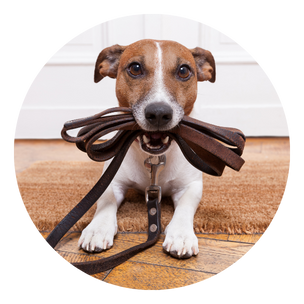Dog Harnesses
Dog Harnesses
Harnesses are an essential dog accessory for many Irish pet owners, offering greater control and comfort compared to traditional collars. Using a harness has key benefits: it distributes leash pressure across the dog’s chest and shoulders instead of the neck, preventing choking and injuries. In fact, a good harness will reduce pulling, increase your control, and decrease stress on your dog’s neck and joints. This makes harnesses a safer choice for vigorous pullers, excited puppies, and breeds prone to throat/trachea issues.
Frequently Asked Questions
Is a harness better than a collar for my dog?
It depends on your dog’s behavior and needs. Generally, a harness offers more control and is better for dogs that pull or have delicate necks. Harnesses distribute pressure away from the throat, which prevents choking and neck injuries that collars could cause if a dog yanks hard.
Collars are fine for ID tags and for dogs that walk calmly, but for most dogs, especially strong pullers, small breeds with fragile tracheas, or short-nosed breeds, a harness is the safer, more comfortable option. Many owners use both: a collar for everyday identification and a harness for actual walking and training.
Collars are fine for ID tags and for dogs that walk calmly, but for most dogs, especially strong pullers, small breeds with fragile tracheas, or short-nosed breeds, a harness is the safer, more comfortable option. Many owners use both: a collar for everyday identification and a harness for actual walking and training.
How do I measure and fit my dog for a harness?
To get the right fit, you should measure your dog’s girth (chest circumference) behind the front legs and sometimes the lower neck circumference, depending on the harness style. Check the sizing chart of the harness brand, sizes are often given in ranges (e.g., 50–70cm chest). When fitting the harness, it should be snug but not too tight: you should be able to slip two fingers under the straps comfortably. Adjust all straps (shoulders, chest/belly) evenly.
A proper fit means the harness is secure and the dog cannot back out of it, but it’s not pinching or causing rolls of skin to bunch up. Tip: If your dog is between sizes, go up to the larger size and adjust it down for a comfy fit. Always read the product’s fitting instructions; some harnesses (like step-in models) have a different fitting method than over-the-head harnesses. Petworld’s team can also help you in-store to size your dog if needed.
A proper fit means the harness is secure and the dog cannot back out of it, but it’s not pinching or causing rolls of skin to bunch up. Tip: If your dog is between sizes, go up to the larger size and adjust it down for a comfy fit. Always read the product’s fitting instructions; some harnesses (like step-in models) have a different fitting method than over-the-head harnesses. Petworld’s team can also help you in-store to size your dog if needed.
Can puppies wear harnesses? What harness is best for a puppy?
Yes, puppies can absolutely wear harnesses, in fact, it’s often recommended. A harness can give you better control of a bouncy puppy and is gentler if they tend to dart or tug suddenly (since it won’t jerk their neck like a collar might). For a young puppy, look for a lightweight, adjustable harness that will grow with them (many have multiple adjustment points). Soft mesh or padded harnesses are great for puppies because they are comfortable and less intimidating to put on.
You might start with a simple step-in harness for ease of use, or any harness that clips on the back, which puppies usually tolerate well. As your puppy grows, keep checking the fit and adjust or upgrade the size. Harnesses also help train puppies not to pull from an early age, pair it with positive reinforcement during walks. Remember, puppies can be wiggly, so take a little time to introduce the harness gradually, rewarding your pup with treats so they associate it with fun outings.
You might start with a simple step-in harness for ease of use, or any harness that clips on the back, which puppies usually tolerate well. As your puppy grows, keep checking the fit and adjust or upgrade the size. Harnesses also help train puppies not to pull from an early age, pair it with positive reinforcement during walks. Remember, puppies can be wiggly, so take a little time to introduce the harness gradually, rewarding your pup with treats so they associate it with fun outings.
Which harness will stop my dog from pulling?
The best type is a no-pull dog harness. No-pull harnesses typically have a front chest leash attachment clip. When your dog tries to pull, the front clip causes them to turn back toward you, reducing their forward momentum, essentially it “steers” the dog and makes pulling less effective. They can be very effective training tools when used correctly.
Keep in mind, no harness alone is a magic fix, you’ll want to combine it with training (reward your dog for walking at your side). Also, ensure the harness is fitted correctly so it doesn’t slide around when the dog pulls. With consistency, a no-pull harness can greatly reduce pulling behavior and make walks more enjoyable.
Keep in mind, no harness alone is a magic fix, you’ll want to combine it with training (reward your dog for walking at your side). Also, ensure the harness is fitted correctly so it doesn’t slide around when the dog pulls. With consistency, a no-pull harness can greatly reduce pulling behavior and make walks more enjoyable.
Do I need a special harness for car travel?
It’s a good idea, yes. A car safety harness is designed to keep your dog secure in the car. These harnesses usually have a robust build and either come with a loop to slide a seatbelt through or have straps that clip directly into the seatbelt buckle. In a sudden stop or accident, a dog that’s unrestrained can be seriously hurt or even injure human passengers.
A properly fitted car harness will act like our seatbelt, keeping the dog in place on the seat. If your dog already has a sturdy harness, you can also use a seatbelt tether accessory that clips to their harness D-ring and into the seatbelt. However, for regular travelers, investing in a purpose-made car harness is wise. It not only protects your pup but also prevents them from distracting you while driving. When using one, always attach it to the back seat (it’s safer than the front). With a car harness, you and your dog can travel around Ireland on road trips with much greater peace of mind!
A properly fitted car harness will act like our seatbelt, keeping the dog in place on the seat. If your dog already has a sturdy harness, you can also use a seatbelt tether accessory that clips to their harness D-ring and into the seatbelt. However, for regular travelers, investing in a purpose-made car harness is wise. It not only protects your pup but also prevents them from distracting you while driving. When using one, always attach it to the back seat (it’s safer than the front). With a car harness, you and your dog can travel around Ireland on road trips with much greater peace of mind!
What is a step-in dog harness?
A step-in harness is a style of harness that your dog literally steps into, making it very easy to put on. Unlike traditional harnesses that go over the dog’s head, a step-in harness is laid out on the ground (forming two loops for the front legs). You have your dog step their front paws into the loops, then you pull up and secure the harness with a buckle on the back.
Many find this design simpler, especially for dogs that are head-shy or get wiggley when you try to put something over their head. Step-in harnesses are also quick to fasten, great for dogs that won’t stand still for long. They provide the same control and safety as regular harnesses once clipped. Just make sure you put it on correctly (it’s possible to get one leg in the wrong hole if the dog is super excited, double-check the straps before clipping the buckle). This type of harness is popular for small dogs and puppies, but they come in all sizes. If you want a fuss-free gear-up routine, a step-in harness is a fantastic choice.
Many find this design simpler, especially for dogs that are head-shy or get wiggley when you try to put something over their head. Step-in harnesses are also quick to fasten, great for dogs that won’t stand still for long. They provide the same control and safety as regular harnesses once clipped. Just make sure you put it on correctly (it’s possible to get one leg in the wrong hole if the dog is super excited, double-check the straps before clipping the buckle). This type of harness is popular for small dogs and puppies, but they come in all sizes. If you want a fuss-free gear-up routine, a step-in harness is a fantastic choice.








